Locomotives -
Operational Locos -
Locos under overhaul -
Locos on static display -
Locos formerly based on the Bluebell
Loco Roster -
Loco Stock List -
Loco Works News -
Join the Loco Dept


British Rail - 'JB' Electro-diesel Locomotive
No. E6040 (later 73133)
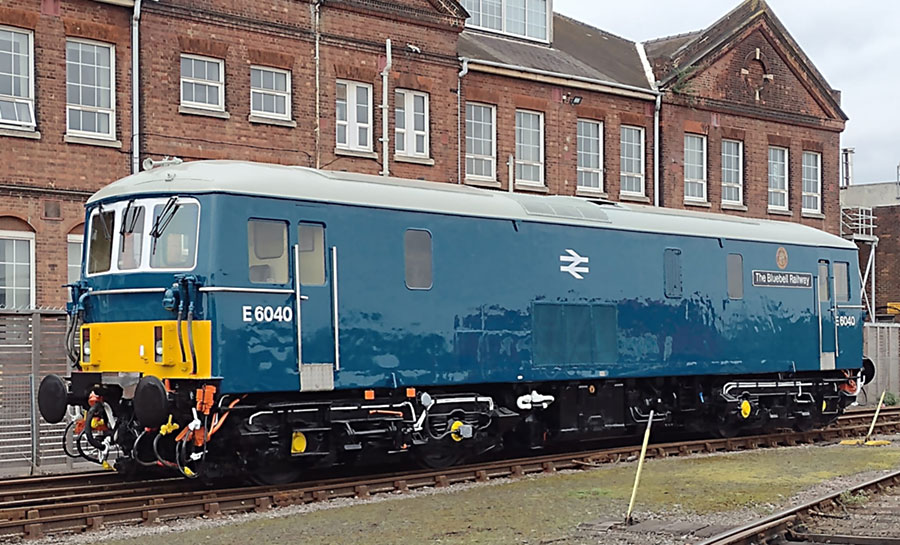
E6040 on completion of overhaul and repainting, at Eastleigh Works on 5 April 2023,
just a few weeks before its arrival at the Bluebell Railway (Paul Auckland)
Pre-history: earlier Southern Electric Locomotives
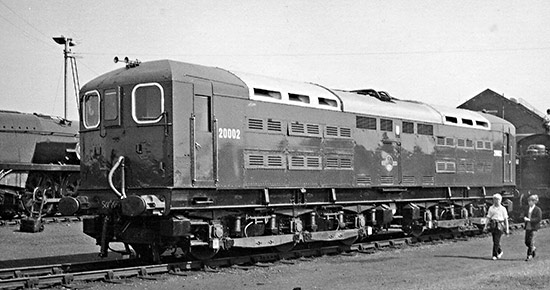
How to power Electric locomotives whilst away from the 3rd rail power source (in goods yards and sidings) was something which had taxed the Southern Railway/Region's locomotive designers from the start. The first three such locomotives, designed by Oliver Bulleid and his Chief Electrical Engineer (Alfred Raworth), were numbers CC1 (later 20001) of 1941, CC2 (20002) of 1945 and 20003 (1948).
Photo right: 20002 at an Eastleigh Works Open Day, 5 August 1964 (Ben Brooksbank - licensed CC BY-SA 2.0)
Known as "Boosters", these experimental goods and passenger locomotives had motor-generator sets incorporating flywheels to avoid the problem of being "gapped" when passing over pointwork with its associated gaps in the conductor rail. To enable them to be used in sidings, they had pantographs, with the sidings equipped with DC overhead power cables for low speed use. The motor-generator sets and flywheels added greatly to the weight of the locomotives, requiring 6-wheel bogies (Co-Co). Being non-standard they were withdrawn, after reliable and productive lives, in 1968-9, having been allocated "Class 70" under TOPS, but as far as is known never carrying the associated new numbers. In 1949 they notably took over the Victoria-Newhaven boat trains from the Brighton Atlantics. Their electric motors were rated at 1,470 hp.
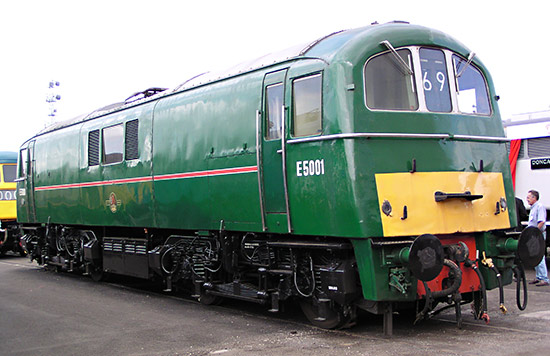
The design was developed later by British Railways into the 'HA' (TOPS Class 71) of which 24 were built in 1959 for the Kent Coast electrification scheme, and they were originally numbered E5000 to E5023 (with E5000 later being renumbered E5024). Like the earlier Southern-designed locomotives, they incorporated M-G sets with flywheels, and pantographs for use in sidings and yards. However advances in electrical equipment design enabled the locomotives to be carried on 4-wheel bogies.
Photo left: E5001 on display at Doncaster Works open day on 27 July 2003 (Phil Scott - licensed CC BY-SA 3.0)
Intended primarily for goods work, with most passengers carried in Electrical Multiple Units, they did notably take over the loco-hauled Golden Arrow and Night Ferry services. With 2,300 hp (continuous) available, they were powerful locomotives. However as the number of goods/freight services on the Southern Region declined, ten were taken out of service in 1964, and in 1967 ten were converted into 'HB' (later Class 74) electro-diesels. With little work for them, the remaining Class 71 locos were withdrawn in 1977, and E5001 is preserved in the National Collection.
The rebuilt 'HB' (Class 74) locomotives were intended for boat trains to Southampton and Weymouth, where the ability to run on diesel power over the final non-electrified tracks down to the harbours was required, coupled with higher power when running on the third rail than the Class 73s. The Paxman 6-cylinder 650 hp diesel engines were fitted in place of the flywheel, auxiliary generators and electrically powered traction motor blowers which were replaced by more compact ones built into the Motor-Generator assembly. Because they had slightly more powerful diesel engines than the Class 73, they tended to be given more demanding "off electric" duties, leading to increased maintenance and hence earlier withdrawal.
'JA's - the first Southern Electro-diesel Locomotives
The intention of the design was to provide an electric locomotive of similar power to the KA (Class 33) diesel locomotives. To enable them to shunt freight trains at slow speed within goods yards, a small diesel engine was decided upon, since this was felt to be a more flexible and universal solution than providing overhead 750V wires. This would also permit their use on track maintenance work. For the safety of track workers when so employed, the live current collector shoes had to be retractable, and this was also required should they run off the 3rd rail electrified network. Further, the locomotives were intended to work in multiple with the region's multiple units (both electric and diesel) and to haul normal carriages and wagons. Thus they were fitted with drop-head buckeye couplings, and 'Pullman' type rubbing bars and associated retractable buffers, giving a truly universal locomotive.
Brian Haresnake recounted in his 1983 BR Fleet Survey Vol 6 - Electric Locomotives, how the form of the roof over the drivers' cabs was copied from that on the Brighton Belle Pullman driving cars.
The 'JA's were effectively six prototypes, designed and built at Eastleigh in 1962 using English Electric equipment. Numbered E6001-6 (later 73001-6) they were built to the narrow 'Hastings Gauge', giving universal track access across the region. Lighter and smaller than the Class 71s, they had lower electric power rating, of 1,420 hp (continuous) and 1,600 hp (one-hour), with an English Electric 600 hp diesel engine similar to those used in the Southern Region's DEMUs. Under TOPS they were originally to be allocated Class 72, but actually became Class 73/0.
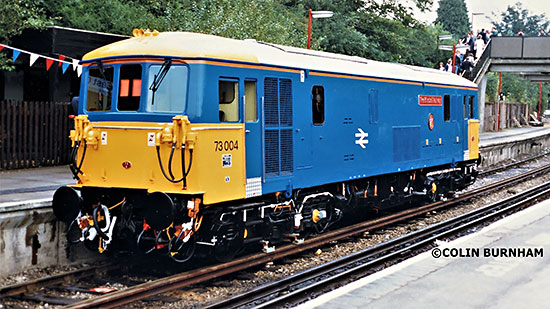
The six prototypes proved highly successful, and two are preserved, one scrapped and one stored as a spares donor, with two still in service 60 years later having been converted to Class 73/9s in 2015 at Brush Traction.
Ironically the example to have been scrapped is 73004, which was named 'The Bluebell Railway' at East Grinstead on 19 September 1987 when this photo was taken by Colin Burnham. It carried the name until 1990, and was withdrawn the following year, after service on Merseyrail. It was used as a source of spare parts for 73003 on the Lavender Line at Isfield, finally being scrapped in 2004.
'JB's - the production fleet
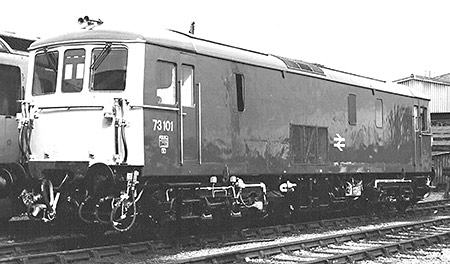
With the 'JA's having proved the concept worked well, 43 more Electro-diesel Locomotives were ordered from English Electric, built at their Vulcan Foundry in Newton-le-Willow, between 1965 and 1967, as part of the fleet to operate the newly electrified Waterloo-Southampton/Bournemouth line. Initially numbered E6007-E6049, they differed slightly from the prototypes, most notably having higher tractive effort and a 90mph maximum speed (as against the JA's 80). Under TOPS they became Class 73/1, being renumbered 73101-73142.
Photo left: 73101, the JB-class pioneer (John Griffiths)
Initially finding wide use across the region, on non-passenger services, in 1984 a number of them were put into front line express use on the Gatwick Express services, where they were worked far harder than ever before, working in push-pull mode with Mk.2 carriages and powered driving luggage vans. Problems with flash-overs when gapped led to the addition of flashguards to their bogies. 73133 was one of those used on early training runs. A sub-class of 14, designated as 73/2s, was later separated out, largely for use on the Gatwick Express services, having their Vacuum brakes isolated and low-level multiple unit connectors removed. The Gatwick Express service largely went over to EMU operation during 2000, but one loco-hauled set remained for maintenance cover until 2005. The locomotives continued to find plenty of use elsewhere.
More recently thirteen of the class (including the two 'JA's) have been converted to 73/9. substantially re-engineered with 1,500 hp of diesel power. Two (equipped with two 750 hp engines) are used by Network Rail, and the others (with a single larger engine) are owned by GB Railfreight and used to haul the Caledonian Sleeper over non-electrified sections of the route, from Edinburgh to Aberdeen, Inverness and Fort William.
Original Liveries
The Southern Region's six 'JA' prototypes were painted initially in varying shades of green but the 'JB's (73/1) carried blue from new, with small yellow warning panels. E6007-10 initially ran without the BR emblems on the bodysides, E6007-13 had a grey band on the lower bodyside, but for E6014 and subsequent locomotives the grey band was omitted.
E6040 / 73133 'The Bluebell Railway'
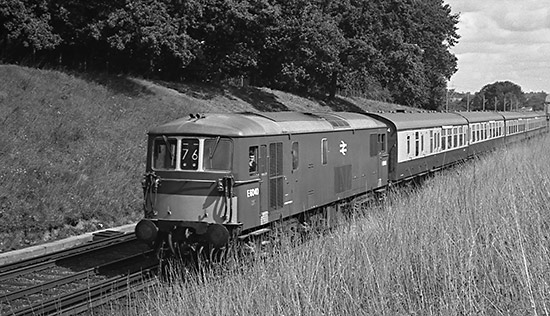
E6040 leaving Wivelsfield with a Victoria to Newhaven boat train - Charlie Verrall - July 1967
There is a colour photo of E6040 in the Linda Chen collection, showing the locomotive at Brighton in 1966. Both of these photos show the locomotive in its original livery.
It received its TOPS number, 73133, in 1973.
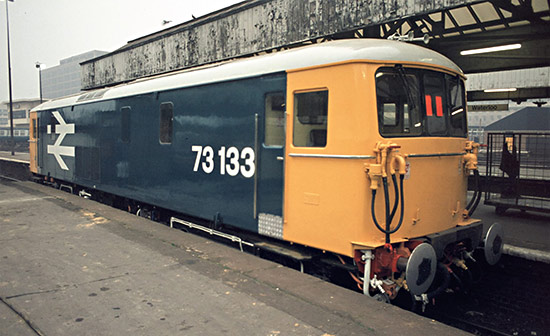
73133 at Waterloo in BR Blue with the big logo - Nigel Menzies - 1 October 1983
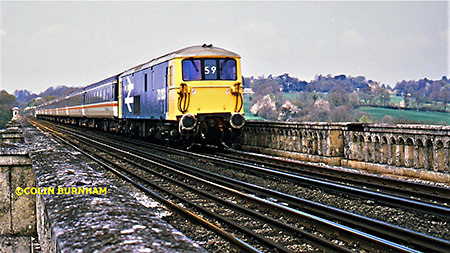
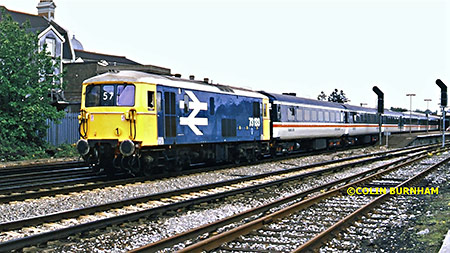
73133 on crew training runs for the Gatwick Express, photographed by Colin Burnham, on the Ouse Valley Viaduct in March 1994 and at Haywards Heath the following month.
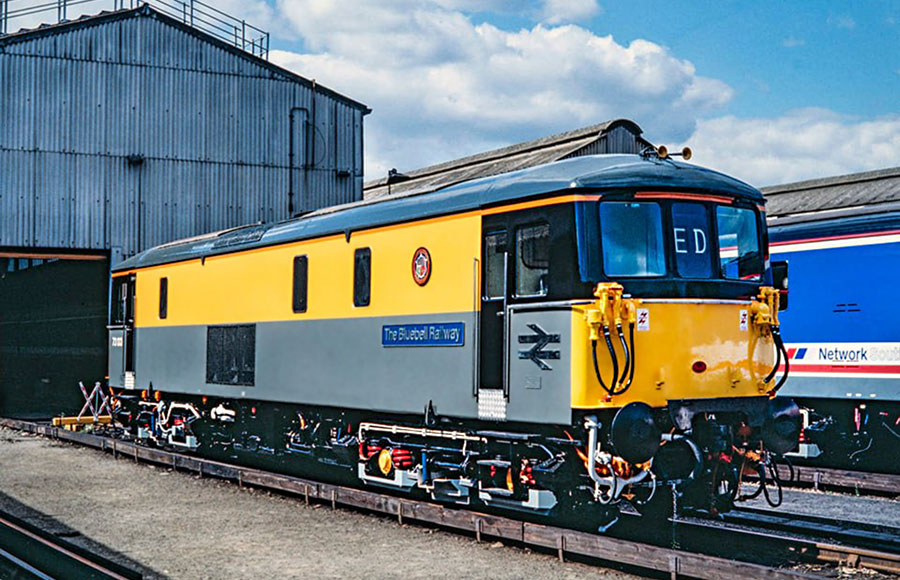
Fitted without ceremony, 'The Bluebell Railway' nameplates and crest appeared on 73133 when it was outshopped from Selhurst's repair shop on 6 September 1990 in Engineer's "Dutch Livery" (one of the first locos to carry that livery, which had been introduced just a couple of months earlier) after a general repair - Colin Marsden.
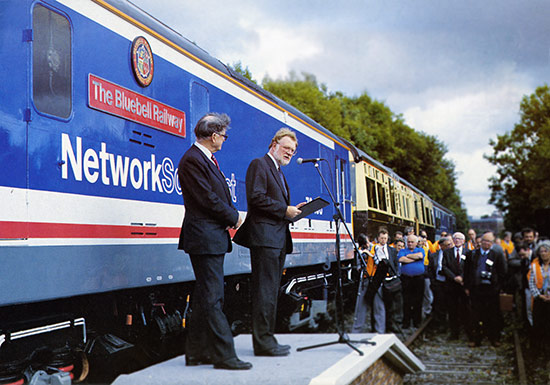
Repainted again after transfer to Network SouthEast, 73133 'The Bluebell Railway' ventured onto the viaduct at East Grinstead as part of the ceremony which took place when John Nelson (MD of Network SouthEast) transferred ownership of the viaduct to the Bluebell - Mike Esau - 8 September 1992
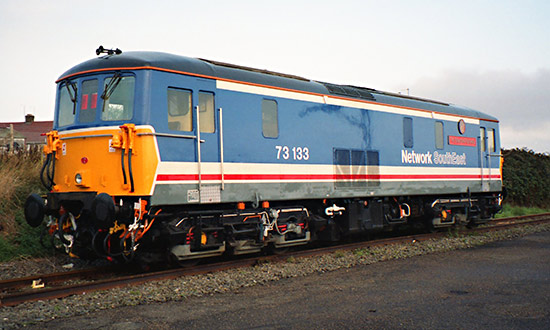
Not long after, 73133 'The Bluebell Railway' is seen in NSE Livery at Queenborough Sidings - Barry Johnson
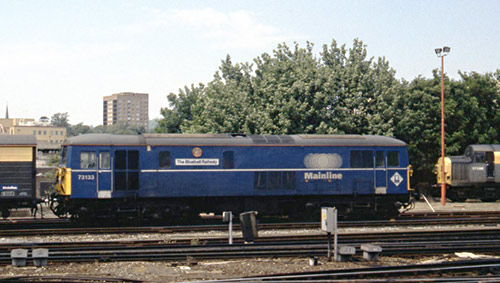
By the time of this photo, 5 June 1997, 73133 was owned by privatised freight haulier Mainline Freight (later to become part of EWS) and is seen here at Redhill - Tony Sullivan
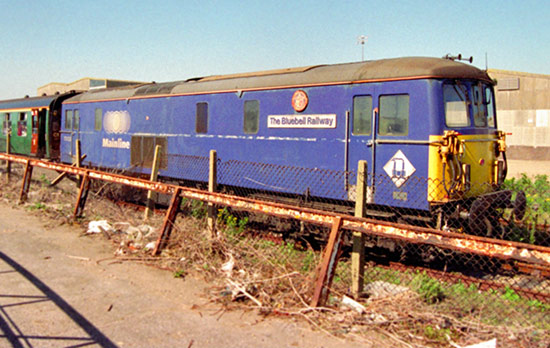
73133 on "The Channel Packet" railtour at Newhaven Marine - Miles Haywood - 1 June 2002
By this time it had lost its blind box, replaced by a central window, for driver training purposes, and gained its light clusters, which are operationally useful for us also on the Bluebell, so reverting that feature to its original condition is not currently a priority.
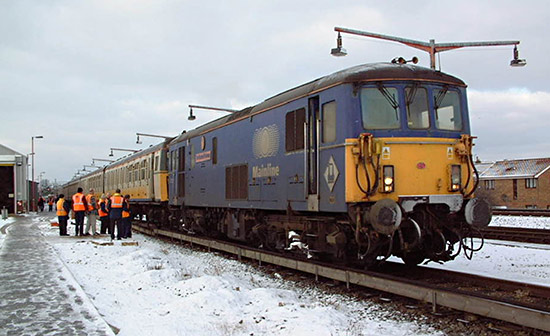
73133 to the rescue - Colin Whitbread - 7 January 2003
73133 'The Bluebell Railway' having rescued a Gillingham to Victoria Service formed of 4CIG 1701 and 4VEP 3496, is seen here after returning them to Gillingam Depot.
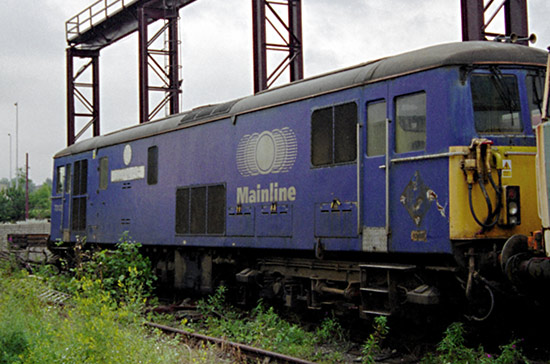
73133 in Booths scrapyard - Miles Haywood - May 2004
73133 lost its name in 2004, and indeed was nearly scrapped, but moved on again, arriving at the Barry Island Railway in South Wales in 2009, and then on again to South West Trains Bournemouth Depot in May 2013 to act as a shunt locomotive. Repainted into a green livery in 2013, and owned by Transmart Trains, it was hired to Arlington Fleet Group at Eastleigh Works from October 2017.
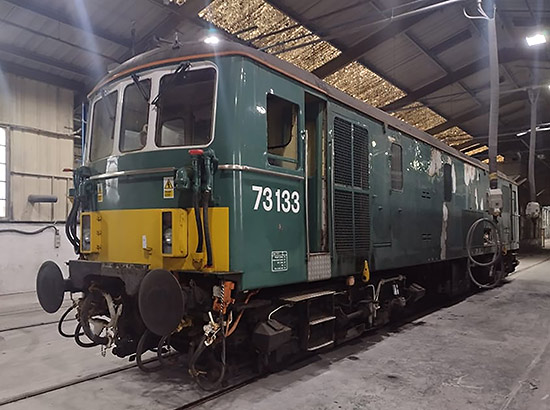
73133 in Eastleigh Works, as its overhaul starts - Paul Auckland - 14 January 2023
Privately purchased in December 2022 by a member of the Bluebell Railway's locomotive department, it has been refurbished at his expense at Eastleigh Works in early 2023, prior to moving to the Bluebell Railway.
As seen in the photo at the very top of this page, 73133 is now painted in its original blue livery with small yellow warning panels, and numbered E6040, and again carrying the Bluebell Railway's coat of arms and named 'The Bluebell Railway'.
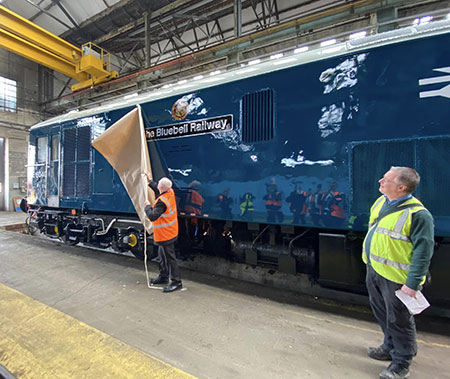
Type: JB (later Class 73/1) Electro-diesel Locomotive
Introduced: JA: 1 February 1962,
JB: 13 October 1965
Built: 1966, English Electric, Vulcan Foundry
Wheel arrangement: Bo-Bo
Number: E6040 (was 73133 under TOPS)
Name: 'The Bluebell Railway'
Power - Electrical: 1,420 hp (continuous)
1,600 hp (one-hour)
(Traction motors: EE 546/1B)
Power - Diesel: 600 hp (English Electric 4SRKT Mk II)
Tractive effort - Electric: 40,000 lbf
Diesel: 36,000 lbf
Maximum speed: 90 mph
Weight: 76.3 tons (as built)
Length: 53 ft 8 in
To Bluebell: 25 April 2023
Owner: Private
Current status: Operational
Facebook Group for this locomotive
Photo right: E6040 being named by Roy Watts at Eastleigh on 5 April 2023 (Neil Glaskin)


Return to BRPS Home Page,
to the Timetable or to Special
Events
Locos Intro -
Operational Locos -
Locos under overhaul -
Locos on static display -
Locos formerly based on the Bluebell
Loco Roster -
Loco Stock List -
Loco Works News -
Join the Loco Dept
Visitor Info. -
Museum -
Trust -
Catering -
Contacts -
What's New -
Projects -
Locos -
Carriages & Wagons -
Signals -
History -
Other -
Links -
Search -
FAQ
Why not become a BRPS Member? -
Get more involved as a Volunteer
Your ideal Film/TV location?
 Page created and text © 8 April 2023 by Richard Salmon.
Page created and text © 8 April 2023 by Richard Salmon.
Last updated by Richard Salmon, 26 April 2023.
Photos © as credited.
© Copyright BRPS. Privacy Policy
|













